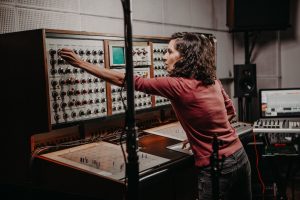Electronic music is composer Svetlana Maraš’ passion. She is Professor of Creative Music Technology and Co-Director of the Electronic Studio at the FHNW in Basel since September 2021 and her composition class will be in charge of SRF 2 Kultur’s radio concert of June 29, as part of the live broadcast “Classical and Jazz Talents” focus series.

Friederike Kenneweg
“Working at the university is of course a challenge in terms of time management, if one doesn’t want to give up the own artistic work,” says Svetlana Maraš.
But to her relief, the composer has found that the two activities don’t get in each other’s way, but rather complement one another.
„ In the creative process I always discover something new with the students – in this kind of interactions in this way of working, somehow it kind of works well together its not different it works in the counterpoint.“
The Serbian composer, born in 1985, had a rather classical musical education, with early piano lessons and music as well as composition studies. At the same time, however, there was always an interest in the possibilities of electronic sound processing, which led her to international workshops and courses and finally to a degree in sound and media art at the University of Helsinki’s Media Lab.
The piece Dirty thoughts by Svetlana Maraš was composed in 2016.
From 2016 to 2021, Svetlana Maraš was composer-in-residence and artistic director of the Electronic Studio of Radio Belgrade. One of the technical gems there is the EMS Synthi 100, an analogue synthesizer from 1971 of which only three were built. Maraš explored the possibilities of this instrument intensively and used it in several of her compositions, including her Radio Concert No. 2, which was created for the 2021 edition of the Heroines of Sound Festival in Berlin.
However, the EMS Synthi 100 is so large and heavy that it cannot be moved. The studio space, on the other hand, is so small that there is no room for a larger audience. So the live performance from the small studio space was video streamed to the festival venue.
While some parts of the piece are fixed, Maraš also creates spaces for herself within which she can improvise, taking advantage of the fact that having explored the instrument for so long, she knows it inside out. „It was not so much about what the instrument can do but what I wanted to do with it“.
Tribute to early electronic music
The historical synthesizers’ richness of sound is completed by the new possibilities offered by computer technologies, but Svetlana Maraš also used the old, analogue technique of tape loops in her radio concert – paying tribute to early electronic music, with which she always sees herself in a dialogue. Pioneers of electronic music such as Delia Derbyshire, Daphne Oram and Éliane Radigue actually come to mind and ear while seeing Svetlana Maraš turning the knobs and pushing the buttons of the EMS Synthi 100.
Before Maraš, only one woman had produced works at the Electronic Studio Belgrade: composer Lyudmila Frajt (1919-1999). As artistic director, Svetlana Maraš dedicated her own concert format to this pioneer in order to pay tribute to her predecessor as well.

Svetlana Maraš points out an important difference between then and now in the fact that analogue studio synthesizers are no longer used as workstations for pre-produced electronic music, but are mainly used live – even if this sometimes has to happen via the diversions of video concerts.
Svetlana Maraš, excerpts from Post-excavation activities, 2020
This year’s Heroines of Sound– Festival in Berlin will feature Maraš’ ‘Scherzo per oscillatori for Minimoog’ world premiere. In this case, however, the composer will not play herself, as the piece is interpreted by pianist Sebastian Berweck. This became a special challenge for the composer, as she first had to develop a special type of notation for the settings of the synthesizer.
in Berlin wird die Uraufführung von Scherzo per oscillatori für Minimoog von Svetlana Maraš zu hören sein. Hier spielt die Komponistin aber nicht selbst das Instrument, sondern das Stück wird von dem Pianisten Sebastian Berweck interpretiert. Das stellte in der Vorbereitung eine besondere Herausforderung für die Komponistin dar, musste sie doch erst eine Art der Notation für die Einstellungen des Synthesizers entwickeln.
Discovering the synthesizer’s sound simplicity
In developing the work, Svetlana Maraš was looking for a certain simplicity: starting from what the synthesiser brings and making it sound without complicating things too much. In the composer’s words: „Depending on what we regard by simple…. It can be small nuances, textures and sounds which are crackling and might sound like a mistake or one single sound which has a very interesting morphing and changes throughout time“
In electronic music, even the creation of something simple can be quite complex, as any determination of sound requires a multitude of decisions in the countless parameters that can be shaped within the instrument.
Electronic music on the radio
Dealing with the infinite possibilities that computer technology provides is also something that Svetlana Maraš teaches her students. When she talks about it, her enthusiasm is plain to see: ” It’s a quite rewarding experience. If I can help find them their voice and their way of working to create what they want, it gives you something back – it gives you a lot..”
This year in particular, the students have a very special opportunity to present their projects to the public at the end of the semester: a radio concert. SRF 2 Kultur’s focus week Classical and Jazz Talentsfrom June 26, to July 3, is dedicated to young musicians. On June 29, students from the FNHW’s Electronic Studio will present pre-produced electronic works created in collaboration with this event in Basel’s Meret Openheimhaus auditorium, live on the radio. Subsequently, the Noise Ensemble of the Electronic Studio Basel will improvise and Welcome to the Radio! a piece by Maraš’ student Dakota Wayne, consisting in a fictional talk show for which he also sampled jingles from Radio SRF 2 Kultur, will be premiered.
Dakota Wayne, Welcome to the Radio!, UA Basel 2022, produced by SRG/SSR
Svetlana Maraš sees this radio concert and performance within the framework of a certain tradition: “It helps the students to understand the importance of radio for electronic music. Even if radio as a medium has somewhat receded into the background lately: when one composes for the radio, it adds something to the music, changing the form, the dramaturgy, the choice of material… I’m glad we can have this experience this year and work on it together.”
Friederike Kenneweg
Mentioned broadcasts SRF 2 Kultur:
Classical and Jazz Talents: from June 26, to July 3 2022: SRF 2 Kultur’s focus week on young musicians: Vollständiges Programm als pdf
Neue Musik im Konzert, 29.6.22: Classical and Jazz Talents – Live from SRF-Auditorium, Redaktion Annina Salis: Livekonzert Contemporary electronic music with students of Svetlana Maraš – Electronic Studio Basel.
7th to 9th of July 2022: Heroines of Sound Festival in Radialsystem Berlin
8th of July 2022 first night of Scherzo per oscillatori for Minimoog by Svetlana Maraš, played by Sebastian Berweck
Svetlana Maraš, Dakota Wayne, Sebastian Berweck, Elektronisches Studio Basel, FHNW Basel
About the Electronic Studio of Radios Belgrade, Podcast about Ljudmila Frajt
neo-profile:
Svetlana Maraš, Elektronisches Studio Basel, Tim Shatnyy, Dakota Wayne, Anton Kiefer, Cyrill Jauslin, Louis Keller, Isaac Blumfield, Janik Pokorny, Minh Phi Guillod

